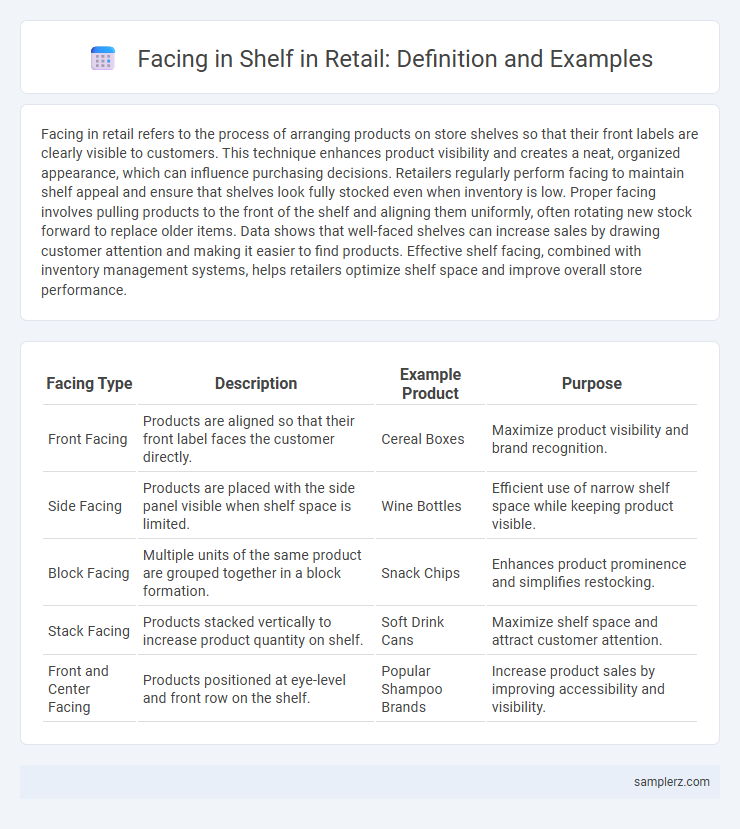Facing in retail refers to the process of arranging products on store shelves so that their front labels are clearly visible to customers. This technique enhances product visibility and creates a neat, organized appearance, which can influence purchasing decisions. Retailers regularly perform facing to maintain shelf appeal and ensure that shelves look fully stocked even when inventory is low. Proper facing involves pulling products to the front of the shelf and aligning them uniformly, often rotating new stock forward to replace older items. Data shows that well-faced shelves can increase sales by drawing customer attention and making it easier to find products. Effective shelf facing, combined with inventory management systems, helps retailers optimize shelf space and improve overall store performance.
Table of Comparison
| Facing Type | Description | Example Product | Purpose |
|---|---|---|---|
| Front Facing | Products are aligned so that their front label faces the customer directly. | Cereal Boxes | Maximize product visibility and brand recognition. |
| Side Facing | Products are placed with the side panel visible when shelf space is limited. | Wine Bottles | Efficient use of narrow shelf space while keeping product visible. |
| Block Facing | Multiple units of the same product are grouped together in a block formation. | Snack Chips | Enhances product prominence and simplifies restocking. |
| Stack Facing | Products stacked vertically to increase product quantity on shelf. | Soft Drink Cans | Maximize shelf space and attract customer attention. |
| Front and Center Facing | Products positioned at eye-level and front row on the shelf. | Popular Shampoo Brands | Increase product sales by improving accessibility and visibility. |
Understanding Shelf Facing in Retail
Shelf facing in retail refers to the practice of positioning products at the front edge of a shelf to maximize visibility and appeal to consumers. Proper facing techniques enhance product exposure, improve inventory control, and influence purchasing decisions by creating an organized and attractive display. Effective shelf facing increases sales by ensuring popular items are easily accessible and visually prominent to shoppers.
Importance of Proper Product Facing
Proper product facing in retail shelves enhances visual appeal, making items more accessible and attractive to shoppers. Strategic facing increases product visibility by aligning labels and packaging toward the customer, which directly boosts sales and reduces inventory shrinkage. Maintaining consistent product facing supports brand recognition and optimizes shelf space utilization, contributing to improved store performance and customer satisfaction.
Popular Shelf Facing Techniques
Popular shelf facing techniques in retail include the "face-out" method, which displays products with their front labels fully visible to attract customer attention effectively. The "block facing" technique groups identical products together in a neat, uniform row, enhancing visual appeal and simplifying the shopping experience. Employing these strategies increases product visibility, encourages impulse purchases, and optimizes space utilization on retail shelves.
Single vs. Multiple Product Facing Examples
Single product facing on retail shelves maximizes visual impact by showcasing one SKU with multiple front-facing units, creating a strong brand presence and simplifying consumer decision-making. Multiple product facings display a variety of SKUs side-by-side, enabling shoppers to compare options and facilitating cross-selling opportunities. Retailers strategically adjust facings based on product category, inventory levels, and target customer preferences to optimize shelf space and drive sales.
Color Blocking: Enhancing Visual Appeal
Color blocking in retail shelf facing uses bold, contrasting colors to draw customer attention and create a visually striking display. This technique highlights product categories or brands, improving brand recognition and shopper navigation. Strategic placement of color blocks can increase impulse buys and elevate overall store aesthetics.
Horizontal vs. Vertical Facing Strategies
Horizontal facing strategies involve placing multiple units of the same product side-by-side, enhancing brand visibility and encouraging bulk purchases by creating an impression of abundance. Vertical facing arranges different product varieties or brands one above the other, allowing customers to compare options easily and promoting a diverse product selection within limited shelf space. Retailers optimize shelf layout by balancing horizontal facings for strong brand presence and vertical facings for variety and customer choice.
Facing for Promotional Items: Best Practices
Facing promotional items on retail shelves involves aligning products front and center with clear, eye-level positioning to maximize visibility and impulse purchases. Utilizing bold signage and consistent shelf organization enhances customer attention and guides quick product recognition. Regularly rotating stock to maintain fresh, attractive displays ensures promotions remain compelling and drive higher sales.
Case Study: Effective Facing in Grocery Stores
Effective shelf facing in grocery stores increases product visibility by aligning items neatly and consistently, which can boost sales by up to 20%. A case study at a major supermarket chain revealed that increasing shelf facings for popular brands enhanced customer engagement and reduced stockouts. Optimizing shelf space through strategic facing supports inventory management and elevates the shopping experience.
Technology Tools for Shelf Facing Optimization
Technology tools for shelf facing optimization in retail include planogram software, shelf-scanning robots, and AI-powered image recognition systems. Planogram software ensures product placement aligns with merchandising strategies, while shelf-scanning robots capture real-time data on product availability and facing angles. AI-driven image recognition enhances shelf compliance by analyzing stock levels and detecting misplaced items efficiently.
Measuring the Impact of Shelf Facing on Sales
Measuring the impact of shelf facing on sales involves analyzing how the number of product facings influences consumer purchasing behavior and overall revenue. Studies show that increasing shelf facings for high-demand products can significantly boost product visibility and sales volume by up to 30%. Retailers use point-of-sale data and eye-tracking technology to optimize shelf layout, enhancing product prominence and maximizing category performance.

example of facing in shelf Infographic
 samplerz.com
samplerz.com